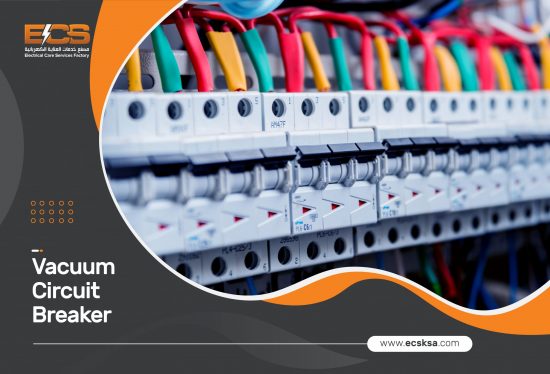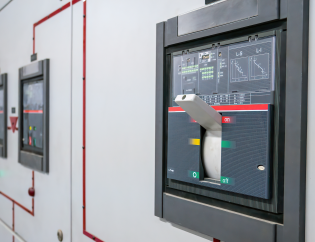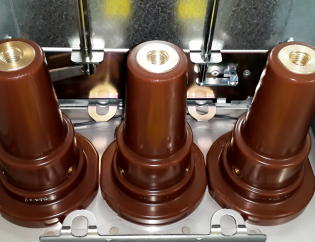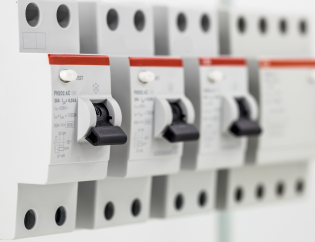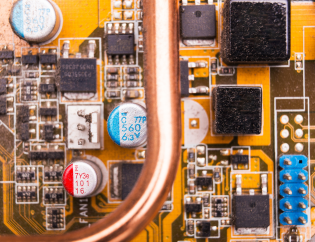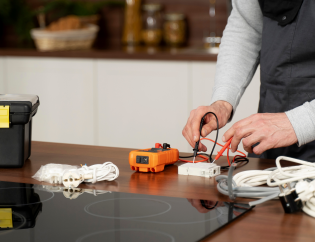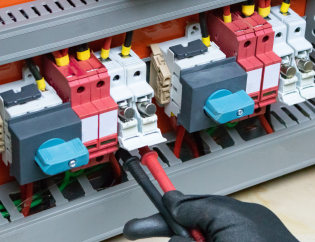The VCB consists of a movable and fixed contact enclosed within a vacuum-sealed casing. When an electrical fault occurs, the movable contact rapidly moves away from the fixed contact, interrupting the flow of current. The vacuum within the casing quickly extinguishes the electrical arc, preventing the formation of harmful gases and ensuring a rapid and reliable interruption of the electrical fault.
VCBs are known for their reliability, high breaking capacity, and long service life, making them a popular choice for electrical switchgear applications in power distribution systems, substations, and industrial plants.
How Vacuum Circuit Breaker Works
A vacuum circuit breaker (VCB) works by interrupting the flow of electrical current in a power distribution system in the event of an overcurrent or short circuit. It operates as follows:
-
Normal operation
Under normal operating conditions, the movable contact and the fixed contact of the VCB are closed, allowing electrical current to flow freely through the circuit.
-
Overcurrent detection
When an overcurrent or short circuit occurs, the overcurrent protection device, such as a fuse or circuit breaker, detects the fault and opens the VCB.
-
Contact separation
The movable contact rapidly separates from the fixed contact, interrupting the flow of current.
-
Arc formation
As the movable contact moves away from the fixed contact, an electrical arc is formed between the two contacts.
-
Arc quenching
The vacuum within the VCB’s casing quickly extinguishes the electrical arc by removing the ionized gases that are necessary to sustain the arc.
-
Vacuum insulation
The vacuum within the casing provides a high level of insulation, preventing the formation of harmful gases and ensuring a rapid and reliable interruption of the electrical fault.
-
Reclosure
After the fault has been cleared, the VCB can be reclosed, allowing the electrical circuit to resume normal operation.
The VCB’s ability to quickly and reliably interrupt electrical faults makes it a key component in ensuring the safety and reliability of power distribution systems.
Advantages & Disadvantages of Vacuum Circuit Breaker
THere are several advantages and disadvantages of vacuum circuit breaker. Some of them are discussed below:
Advantages of Vacuum Circuit Breaker (VCB)
- High Reliability: VCBs are known for their high reliability and low failure rate, making them a popular choice for electrical switchgear applications.
- Long Service Life: VCBs have a long service life and are designed to operate for many years without maintenance.
- High Breaking Capacity: VCBs have a high breaking capacity, which allows them to interrupt high levels of current in the event of a fault.
- High Insulation: The vacuum within the VCB’s casing provides a high level of insulation, ensuring reliable performance and protection against electrical hazards.
- Environmentally Friendly: VCBs do not produce harmful gases, making them environmentally friendly.
Disadvantages of Vacuum Circuit Breaker (VCB)
- High Cost: VCBs are typically more expensive than other types of electrical switchgear, making them a less cost-effective option for some applications.
- Complex Design: VCBs are more complex than other types of electrical switchgear, making them more difficult to maintain and repair.
- Limited Applications: VCBs are typically only used in high-voltage electrical systems, limiting their use in some applications.
- Sensitive to Contamination: The vacuum within the VCB’s casing is sensitive to contamination, ensuring that the VCB is installed and maintained in a clean and dry environment.
Despite its disadvantages, the VCB’s high reliability, long service life, and high breaking capacity make it an attractive option for many electrical switchgear applications in power distribution systems, substations, and industrial plants.
Applications of Vacuum Circuit Breaker
Vacuum Circuit Breakers (VCBs) are widely used in various electrical power distribution applications due to their high reliability, long service life, and high breaking capacity. Some of the common applications of VCBs include:
- Power Distribution Systems: VCBs are commonly used to protect electrical circuits and equipment from overcurrent and short-circuit conditions.
- Substations: VCBs are used in substations to isolate electrical circuits in the event of a fault, ensuring the safety and reliability of the electrical power distribution system.
- Industrial Plants: VCBs are used in industrial plants to provide reliable protection against electrical faults and to ensure the safety of electrical equipment and personnel.
- High-Voltage Applications: VCBs are often used in high-voltage electrical systems, such as transmission lines, due to their high breaking capacity and ability to interrupt high levels of current in the event of a fault.
- Renewable Energy: VCBs are also used in renewable energy systems, such as wind and solar power plants, to provide reliable protection against electrical faults.
VCBs are widely used in various electrical power distribution applications due to their high reliability, long service life, and high breaking capacity. By choosing the appropriate VCB for your application, you can ensure the safety and reliability of your electrical power distribution system.
Conclusion
In conclusion, Vacuum Circuit Breakers (VCBs) is crucial in ensuring the safety and reliability of electrical power distribution systems. VCBs are known for their high reliability, long service life, and high breaking capacity, making them an attractive option for many electrical switchgear applications. They are commonly used in power distribution systems, substations, industrial plants, high-voltage applications, and renewable energy systems. Despite their high cost and complex design, the benefits of using VCBs in ensuring electrical safety and reliability make them an essential component in many electrical power distribution systems.
Upgrade Your Electrical Switching System with ECSKSA’s Vacuum Circuit Breakers. Experience Increased Reliability, Safety, and Efficiency Today! Contact Us for Expert Solutions and Installation.
Do you have a question in your mind? If so, make sure to fill out the form below!

